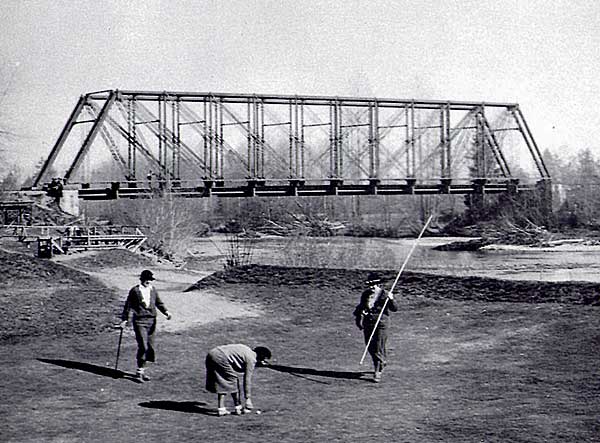
There are three bridges over the river that runs through the small town where I grew up. Each has been cleverly named by the hard-working colonial sorts that carved the town out the wilderness at the far-flung westernmost end of the British Empire. Furthest upstream of the three is a bridge that is painted white, known as White Bridge. Furthest downstream is the bridge that has always been painted metallic silver, known as Silver Bridge. Between the two is the oldest bridge, the very reason for the town's existence, the black iron rail bridge known, of course, as Black Bridge.
Before I get into the story I mean to tell, understand the character of this town. In the 1980's the Ministry of Highways, presumably because of a good deal on green paint, decided that all bridges under their mandate were to be painted the same colour green. The citizens of my home town were livid, very nearly up in arms. How dare the ministry do something so absurd as paint Silver Bridge green? Rallied by the owners of the Silver Bridge Inn the townspeople wrote angry letters to the provincial legislature, the local papers, and the "important" newspaper out of Victoria, the Times Colonist (formerly the British Colonist, which merged with the Victoria Times) - a sure sign that this was a big deal. The people prevailed and to this day Silver Bridge is the only bridge on a provincial highway in British Columbia that isn't green.
The same
spritus mundi maintained strict traditions around Black Bridge as well. Black Bridge crosses the river at a point were the river bends sharply and swirling winter floodwaters have dug out a very deep pool, making Black Bridge ideal for the daring to jump off. My mother used to jump off the bridge when she was young, and new to the town and Canada, sixty years ago. My siblings all had their turns jumping off the bridge. Everyone did it. It was a necessary right of passage, particularly for boys. Every possible platform suitable for leaping from was named with the same inescapable pragmatism that the bridges themselves were named. There was the lowest-most point, the protruding bottom portion of the I-beams supporting the bridge deck, "Bottom". The rails next to the bridge deck and tracks, "Rail". The points where the torsion bars criss-crossed between the superstructure were "First Cross", "Second Cross" and "Third Cross". The top of the superstructure was "Top."
"Bottom" was about 10 metres above the water. "Rail" 12 metres, "First Cross" about 15 metres, "Second Cross" about 18 metres, "Third Cross" another three metres higher, and "Top" about 25 metres or so over the water. Bottom was considered only suitable for small children, girls, and those ancient folk over 30 that insisted on embarrassing themselves. No boy over the age of 12 would consider the humiliating climb down to rail and those that did were guaranteed to be - literally - spit upon by the older boys standing on Rail.
Rail was by far the most popular place to jump from. Rail was about a metre above the bridge deck and tracks and was really a number parallel rails about two centimetres wide and about four centimetres apart that bound together the pillars that supported the I-beams that supported the bridge deck and the criss-crossing torsion bars that kept the bridge stable. Altogether Rail was about a metre and a half wide and an easy place to stand and talk with your friends, finish the smoke you lit before walking on the the bridge, and to moon the Day-Liner passenger train full of tourists when it went by. Jumping from Rail was easy, just a running step and then a glorious second of gangly, flailing, teenage arms and legs before hitting the cool water and climbing up to do it again.
First-time jumpers were always given the same advice by the more experienced. Just look once to make sure you won't hit anyone or anything, take a deep breath, and jump. Once you hesitate and start to think, you'll think yourself out of it and never be able to go. And chickening out from rail was another sure-fire way to find yourself being spit upon. And understand we are talking about the most disdainful lougies and greenies that teenage boys could muster. Those that hesitated usually did jump eventually simply out of the overwhelming compulsion to wash and never hesitated again.
That was the lesson. After the practical moment of planning one's trajectory came the Zen instant of launch, then flight. The fear never went away, that's what made it fun. It was always there in that split second when the unnamed Zen master inside pulled the arms and legs that weren't really your own and flung the eyes in your head into the sky between the bridge and water. Fearless action is no fun. That fear was the thrill. That's what brought you back.
Jumping was all about learning to face fear. Just take a deep breath and jump. The better you got at it, the higher you could go. You couldn't jump from the crosses without facing the mortal fear of failing. Just climbing the torsion bars took a kind of lunatic courage, let alone flinging yourself off. And above Rail there was no one to spit on you. Going higher you only had your own fear to face—and that was the whole reason for doing it.

|
Golfers in front of Black Bridge, c. 1920.
|
